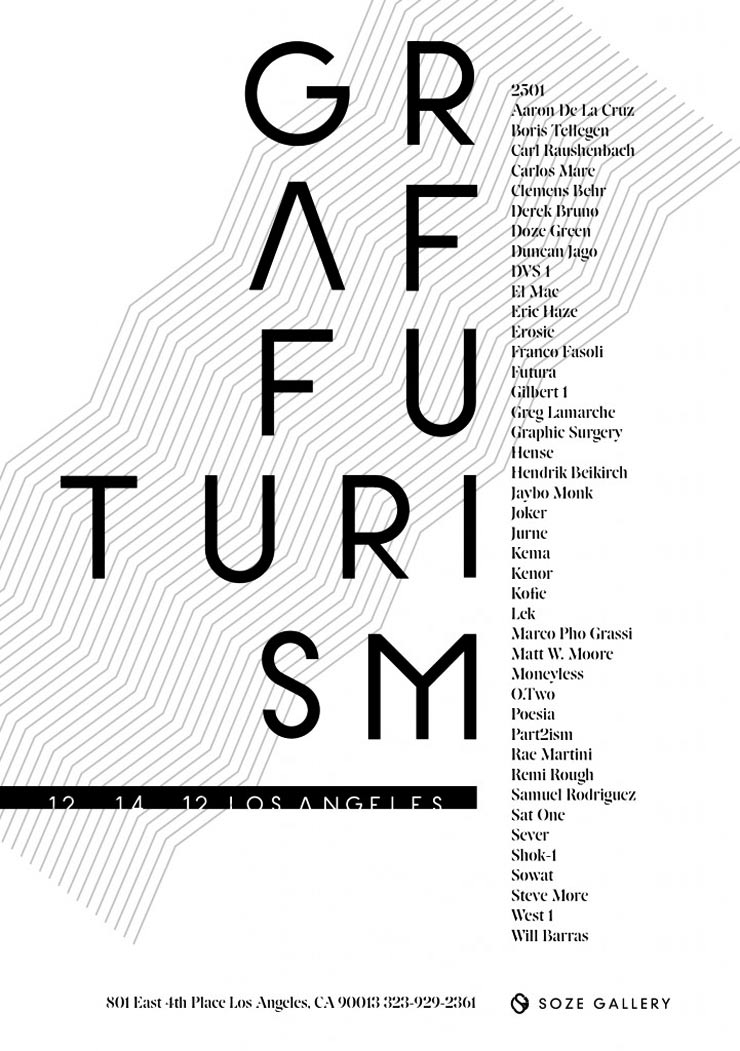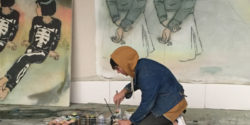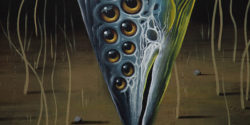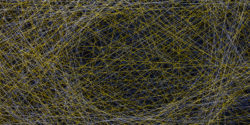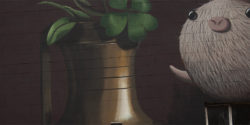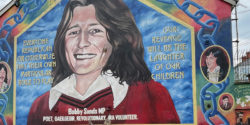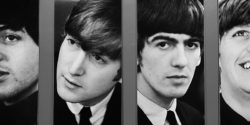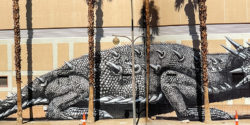Graffuturism.com, opens in the new Soze Gallery location at 2020 E 7th St, Unit B, Los Angeles, CA, 90021.
Since Graffuturism’s inception as a public blog and private Facebook group in 2010, there have been two major group exhibitions that featured associated artists: “Rudimentary Perfection” in Glasgow and “Futurism 2.0″ in London. Both were successful in their curatorial intentions and created a sense of community and motion for the movement. Soze Gallery also has been an early advocate hosting solo exhibitions in 2012 by Jaybo Monk, Moneyless, Remi Rough, Dale Marshall, and a two-man show with Augustine Kofie
and Jaybo. Recognizing the significance of the Graffuturists, Soze Gallery also presented the opportunity for Poesia to curate this exhibition, which he chose to simply call ““Graffuturism.” This exhibition has been eagerly anticipated as the first group show to be curated by Poesia, because he is the founder of Graffuturism.com and also a well-respected graffiti artist with a twenty-year history. Ending up in this unique dual position as artist and commentator, it has fallen on him to be the cultural instigator and diplomatic facilitator of this renewed interest, practice and discourse surrounding what he calls “Progressive Graffiti,” which has also previously been called “Abstract Graffiti.” At this juncture in the three-year history of the website, as well as in the thirty-year history of this over-looked aesthetic trajectory within the Graffiti movement, Graffuturism.com has become a hub and Poesia the dedicated and consistent chronicler and theoretician. With the internet as his podium and round table, he has been historicizing and canonizing these artists, young and old, who have been creating art outside the norms of traditional graffiti, esoteric forms of painting and sculpture that veer outside of the proscribed boundaries into the experimental, the abstract, the poetic, and the hybrid.Artists that fall under the term Progressive Graffiti are generally innately gifted draftsmen, who aspire to a Master’s Level at their craft. Overall this movement could be classified as a “High Style New Millennial Aesthetic.” The art they produce is derived from a dialogue that ricochets around within a pin-ball matrix constructed of coordinates lying between the historical and the contemporary, including high and low influences, fine art and graffiti studies, scholarly and street pursuits, intellectual and visceral marks. Whether the resulting output is graffiti, painting, murals, design, sculpture or installations, the pictorial elements are mutated and transformed through each artist’s unique vision into a personal vocabulary of cross-pollinated styles. Whereas the Street Art movement of the mid-2000s tended to focus on figurative stencils and wheat-pastes, this group of artists on the whole is more concerned with hands-on, singular creation, whether within an academic or street setting. Unlike Post-Modernism, the resultant overall aesthetic is a seamless personal statement, not a collaged juxtaposition of historic styles.
Because of Poesia’s dual roles within the movement, he as been in the unique position to attract this international line up of esteemed contemporary artists, which includes many of the significant forefathers from the seventies and eighties. As a result, by including so many of these original Masters, he has created a chronological continuum within the line up, which defines this historical thread from its earliest days. Therefore this group show has developed into a “survey” that historicizes and canonizes each artist within the Progressive Graffiti thread, as well as within the larger Graffiti movement. One of the earliest, and possibly the most influential to most these artists, is Futura. In the early eighties, after a ten-year career as one of the early seventies writers, he broke away from one of graffiti’s most sacred traditions, the letterform as subject matter. At that point he began to paint in what became known as an “Abstract Graffiti” style. With his groundbreaking subway whole-car “Break,” as well as on the canvasses he was painting at the time, he pushed an atmospheric geometric style to the forefront of his work and began to experiment with a wide array of experimental spray can techniques that had not been seen before.
Around this same time, other early NYC writers, who had also started their careers in the seventies, began to experiment with new hybrid directions not based in pure graffiti traditions. In 1985, Carlos Mare began to combine abstraction and Wildstyle within the medium of sculpture, which over the past couple of decades has expanded to include other mediums under the term Urban Modernism. Haze also began to cross over into the fine art domain and over the years has created a body of work that might be referred to as Iconographic Minimalism. Doze Green was also a significant member of the early community of writers who crossed over with an experimental style that included the use of archetypal icons, poetic typography, figurative motifs and painterly styles. West was also another early intrepid explorer, adopting a gestural expressionist style, applying the muscle memory of train and wall painting to the canvas with his long whole-body marks and splashy, dripping strokes.
This exhibition has also united artists from the second generation who took off along the path forged by those early pioneers. These artists started to formulate their progressive aesthetics in the late eighties, such as Delta, the European three-dimensional geometric letterform pioneer turned pure abstractionist; New Yorker Greg Lamarche aka SpOne, who has been able to establish an abstract typographic collage aesthetic parallel to his foundation as a graffiti writer obsessed with the hand-written letterform; Part2ism was one of the earliest UK experimentalists in Hyperrealism, as well as co-founder of the Ikonoklast Movement in the UK with Juice126, which also came to include abstract colorist Remi Rough in the early-nineties.
Also beginning in the late eighties on the West Coast of the US, the Wildstyle-reductionist Joker was one of the first graffiti artists to paint purely geometric abstractions and pushed for its acceptance within the graffiti community by founding the Transcend Collective in 1991 with She1, who was an abstract writer in the UK. Poesia, became a key member of the collective in 1995, exploring a more hybrid, expressionistic approach to Wildstyle, as well as taking it into pure abstraction, which he is currently pushing in new directions, as well as reaching back to the Baroque painters and reinterpreting their masterpieces as graffiti-dissected new millennial re-paintings. Over in Europe, first in Paris then Italy during the same time period, Marco Pho Grassi started out as a wall and train painter but quickly started mixing in abstraction and more painterly expressionist techniques much like Poesia, yet totally unknown to each other. Then in the mid to late nineties, back in the US along the West Coast, other artists with alternative, experimental mind-sets, who were aware of recent developments, were coming out with brilliant, refined hybrid styles, such as Augustine Kofie and El Mac.
Artists such as these had been forced to skirt the edges of graffiti culture as well as the fine art world for the past ten to thirty years. Due to the esoteric nature and hybrid aesthetics of their graffiti-based paintings, and their disparate locations around the globe, they had no way to band together or find an audience to support them because of the lack of enough interest in their local communities for their esoteric and singular aesthetics. On the other side of the tracks, they were also ignored by the fine arts establishment because of their association with graffiti culture and for unabashedly continuing their gallery-related practices under the term Graffiti, which they still did not entirely leave behind. But, as the world population grows and becomes more connected through the internet, these geographically disparate artists have found it easier to come together, work together, and share global opportunities with each other, rather than being confined to tiny local communities.
Now, as this historical thread comes of age and recognizes itself in the mirror of history and on the faces of its youth, as the pioneers of the culture are canonized and the younger artists are united, there are many more opportunities afforded them within the design market, auction houses and fine art world, as these communities continue grow in their recognition of the cultural value and influence of Graffiti and Street Art, as the most prevalent styles and art movements in the late twentieth and early twenty-first centuries. This particular Graffuturist group exhibition, as well as the previous two, are significant steps in the growth of awareness and activity. This is a significant exhibition because it connects all the artists across the continuum of this overlooked historical trajectory back to these forefathers to finally make the connections and give the recognition due to Progressive Graffiti in all its current manifestations and their historical referents.
Across the board, 2012 has been an explosive year for Progressive Graffiti. The synchronicity of all these group exhibitions and solo shows can only emphasize that there is increased activity by the artists and an amplified interest in the audience. Futura had his first solo show in ten years, which attracted a massive turn out of the wealthy and the fashionable, as well as the highly-respected hardcore members of the graffiti community, which is a testament to his growing importance outside the culture, as well as cementing his stature within it. Following on the heels of the success of his solo show, Futura exhibited with two other crucial esoteric Old School Masters, Rammellzee and Phase2, in conjunction with the Modernist Master Matta in the exhibition “Deep Space” in NYC. This exhibit was particular significant because it canonized these three graffiti artists within the fine art pantheon by successfully illustrating their undeniable aesthetic accomplishments in relation to Matta’s masterworks. Rammellzee also had a banner year, being included in the “Vocabularies Revitalized” exhibition at the MoMA, as well as being given a complete retrospective at the Children’s Museum, both of which were in NYC, not even to mention his solo show at the Suzanne Geiss gallery in 2011 called “The Equation.”
In London, also significant in its curatorial aims to canonize and historicize, as well as it’s grand scope, was “Futurism 2.0,” which compared and contrasted the Futurists and the Graffuturists in an exhibition, book and documentary. Another group show of significance was BrooklynStreetArt.com’s exhibition “Geometricks” which held high the torch of Abstract Graffiti in it’s title and Progressive Graffiti in its roster, which included Hellbent (the curator), Augustine Kofie, Drew Tyndell, Momo, OverUnder and SeeOne. One of the most significant of the many murals and “in situ” collaborations painted this year by Graffuturist-related artists was the abstract mural painted on the Megaro Hotel by Agents of Change members Remi Rough, Augustine Kofie, Lx.One, and Steve More, which is currently the largest mural ever painted in London. Also, a slew of solo and duo exhibitions opened every month around the world by many of the artists associated with Graffuturism and Progressive Graffiti: Poesia, Dale Marshal, Part2ism, Remi Rough, Augustine Kofie, Jaybo Monk, Mark Lyken, Moneyless, Carlos Mare, She One, Matt W. Moore, Jurne, Greg Lamarche, Delta, Hense, Rae Martini, Marco Pho Grassi, and Graphic Surgery. In order to see the full scope of activities though, one would have to go back through Graffuturism.com for a complete review.
Above and beyond the growing interest in Progressive Graffiti is the expanding interest in the over-all culture as well during these first two decades of the new millennium. Massive museum exhibitions encompassing the full spectrum of subcultures and historical threads within the Graffiti and Street Art cultures have also opened to wide acclaim. The success of ticket sales for “Street Art” in 2008 at the Tate Modern in London and “Art in the Streets” in 2011 at the MOCA in Los Angeles revealed the mass cultural interest of these art movements and all the art forms that are connected to them. The fact that these two exhibitions happened at all signifies the growing acceptance by the fine art community as well.
These museum exhibitions, as well as the trend towards many other smaller historical exhibitions, such as “Deep Space” and “Futurism 2.0” at the end of 2012, and “Pantheon: A history of Art from the Streets of NYC” in 2011, indicate a new interest in the study of the history and cultural significance of these movements. Other indicators are the release of high quality scholarly books, articles and movies, such as “Abstract Graffiti” by Cedar Lewisohn in 2011; “Beyond Graffiti” published in ArtNews in 2011 by Carolina Miranda; the 2005 documentary “Next: A Primer on Urban Painting” by Pablo Aravena; and “The Feral Diagram 2.0: Graffiti and Street Art” published in 2012 by Daniel Feral. These are all testament to the growing enthusiasm of scholars, historians, and theoreticians to examine, define and record the fifty year history of graffiti and street art, and recently in particular the Progressive Graffiti thread. Like any misunderstood movement before these, such as rock’n’roll, comic books, and cinema, eventually the art forms, the audiences and the scholars united to finally recognize the movement’s undeniable cultural value, relevance and resonance in all their forms from the simple and visceral to the esoteric and intellectual.
Text by Daniel Feral
On Friday, Dec 14, 2012, the eponymously-titled “Graffuturism” exhibition curated by Poesia, the founder of Graffuturism.com, opens in the new Soze Gallery location at 2020 E 7th St, Unit B, Los Angeles, CA, 90021.
The complete artist list in alphabetical order by first name is as follows: 2501, Aaron De La Cruz, Augustine Kofie, Boris “Delta” Tellegen, Carl Raushenbach, Carlos Mare, Clemens Behr, Derek Bruno, Doze Green, Duncan Jago, DVS 1, El Mac, Eric Haze, Erosie, Franco “Jaz” Fasoli, Futura, Gilbert 1, Greg “Sp One” Lamarche, Graphic Surgery, Hense, Hendrik “ECB” Beikirch, Jaybo Monk, Joker, Jurne, Kema, Kenor, Lek, Marco “Pho” Grassi, Matt W. Moore, Moneyless, O.Two, Part2ism, Poesia, Rae Martini, Remi Rough, Samuel Rodriguez, Sat One, Sever, Shok-1, Sowat, Steve More, West, Will Barras.
Other Articles You May Like from BSA:
Lapiztola & Said Dokins. Del Barrio / Mi Merced Mexico City. 2017. (photo © Leonardo Luna) The writing is on the wall. Can you read what it says? Lapiztola & Said Dokins. Del...
Our weekly focus on the moving image and art in the streets. And other oddities. Now screening : 1. Kahbahbloom: The Art and Story Telling of Ed Emberley 2. Fintan Magee / The Exile 3. Amuse.126...
Our challenge in the new world may not to fly, but to be grounded. Felipe Pantone: Transformable Systems at Joshua Liner Gallery. Manhattan, NYC (photo © Jaime Rojo) Felipe Pantone may see the dan...
Street Artists Icy & Sot are thinking about the ocean. More specifically they’re thinking about its largest resident, the blue whale. Icy & Sot. Endangered Species Mural Project. Los Angele...
A. It has a good name, and B. It’s the way Wynwood feels every year during Art Basel and this self published book by photographer Andrew Kaufman captures the excitement unpretentiously. Andrew Kau...
 BROOKLYN STREET ART LOVES YOU MORE EVERY DAY
BROOKLYN STREET ART LOVES YOU MORE EVERY DAY